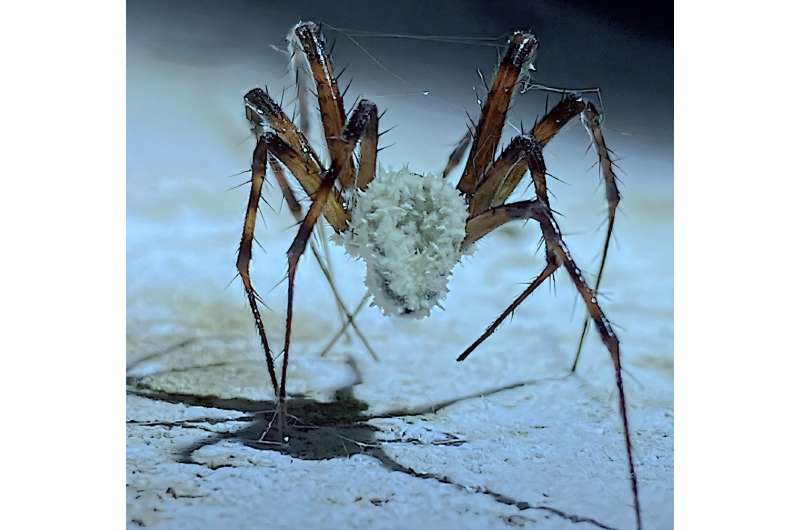This week, astronomers reported the discovery of a super-Earth potentially capable of sustaining life, occupying an eccentric orbit around its star that oscillates in and out of the habitable zone. The first mouse engineered with embryonic stem cells from two dads has lived into adulthood. And researchers reconciled morphological and genomic evidence of the geographic origins of domestic sheep over millennia, shedding light on human migration.
Additionally, researchers discovered a brain-controlling fungus that infects spiders; physicists provided evidence that you can’t escape the second law of thermodynamics even in the quantum realm; and researchers think the morphological differences between dog breeds have less to do with task-specific breeding and more to do with how cute they are.
Spider zombies
Biologists with an international research collaborative discovered a brain-controlling fungus that infects orb-weaving cave spiders, altering their normally reclusive behavior toward risky exposure in order to spread the infection. We don’t normally run “photo of the week” stories, but if we did, the infected spider pictured above would win so resoundingly that next week’s candidates would withdraw their nominations because it would absolutely win again. Sometimes nature’s majesty really does produce creatures that look like Doom enemies.
Anyway, like Ophiocordyceps, the fungus that similarly infects the brains of ants, the new fungus, Gibellula attenboroughii, induces Metellina merianae orb-weaving spiders to leave their shadowy dens and occupy the ceiling spaces of caves to disperse fungal spores, and where they are generally more likely to die. The researchers named the fungus after venerable natural historian Sir David Attenborough. The researchers found more fungal specimens in cave systems in Northern Ireland and the Republic of Ireland, including infections in a related spider, Meta menardi.
Disorder inevitable
The immutable second law of thermodynamics states that entropy in a closed system will increase over time. Everything grows more disordered, the center cannot hold, the falcon cannot hear the falconer. On the other hand, quantum physics leads to a lot of weird and seemingly counterintuitive phenomena, so when physicists like good old John von Neumann point out that entropy in quantum systems mathematically appears to remain the same, you just throw up your hands and say sure, why the hell not.
Specifically, von Neumann observed that if you have the full information about a quantum system, the entropy stays the same and it is impossible based on observation to determine if time is running forward or backward. Maybe you can somehow take hope in that.
Well, proving that the center indeed cannot hold, researchers at the Vienna University of Technology have addressed this quantum loophole in the second law with a paper finding that if you define entropy in a way compatible with quantum physics, entropy will also increase in an initially ordered quantum system until it reaches a final state of disorder. The reason, according to the researchers, is it’s literally impossible to know the full information about a system. Because knowledge of a quantum system can only be based on probabilities, calculating the entropy of a specific observable within the system could produce a result in which the observable changes over time while the system itself does not.
Functional cuteness
As a counterpoint to the story about fungal spider zombies and the terrifying photo that accompanies it, researchers at Chapman University studied the skull morphology and behavior of cute dogs to examine the prevailing belief that certain dog breeds are inherently better at specific tasks. After all, selective breeding has produced dogs for herding, guarding and hunting; in addition to exhibiting desired behaviors, do these dogs also have task-driven body morphology?
The researchers used 3D reconstruction techniques to analyze 117 skulls from 40 domesticated dog breeds and 18 wild dog species. They report substantial overlap in skull shapes across the breeds and functional categories, and little evidence that breeds selected for specific tasks have distinct morphological characteristics that enhance their performance. For example, bite-force measurements did not have significant differences between those dogs bred for bite work and other breeds.
“Our study shows that, at least for their skulls, they are not specialized for tasks that involve the skull, such as biting tasks and scent work,” says Lindsay Waldrop, assistant professor of biological sciences at Chapman University. Instead, the researchers suggest that differences between most physical characteristics among dog breeds may be selected by humans for aesthetic reasons.
© 2025 Science X Network
Citation:
Saturday Citations: Spider zombies; the morphology of cute dogs; entropy is coming for everyone (2025, February 1)
retrieved 1 February 2025
from https://phys.org/news/2025-01-saturday-citations-spider-zombies-morphology.html
This document is subject to copyright. Apart from any fair dealing for the purpose of private study or research, no
part may be reproduced without the written permission. The content is provided for information purposes only.

